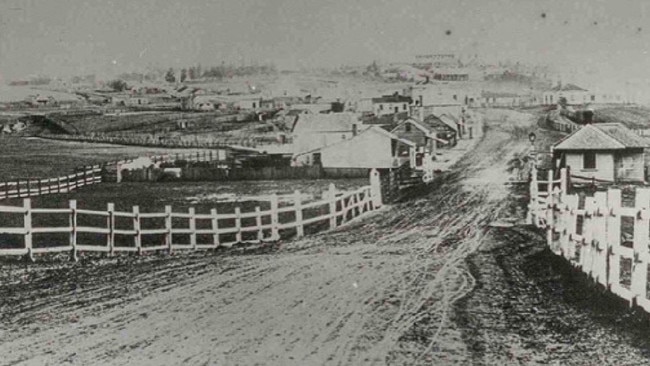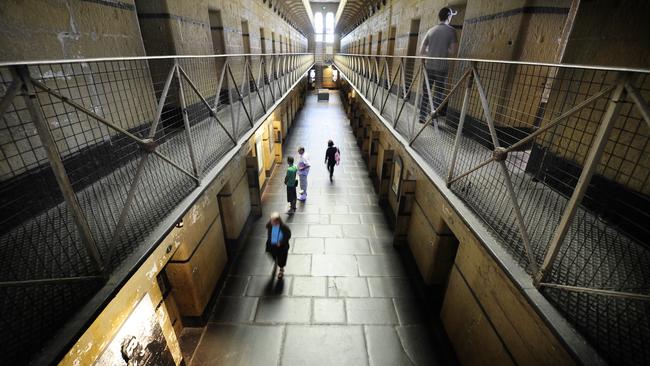Frederick Turner: Callous act that ensured a young bushranger hanged
A 22-year-old on death row believed he would be spared the death sentence — but found himself on the end of the hangman’s noose.

True Crime
Don't miss out on the headlines from True Crime. Followed categories will be added to My News.
Frederick Turner was a young man with a plan to rob his way through life.
Sadly for him, life as a bushranger led him to the gallows at the tender age of about 22.
And it didn’t matter at all that he admitted giving a false name to protect his family following his arrest, or that his true identity was never known.
Turner is the subject of the latest episode of the In Black and White podcast on Australia’s forgotten characters, available today.
Turner told the court that he arrived in Melbourne with his parents and brother aboard the William Jardine in 1849. But he told them little else about his past.
Turner shot one of two men he and two accomplices bailed up on Flemington Rd on Saturday, March 21, 1857.
Just over a month later, he was executed at the Old Melbourne Gaol.
Thomas Moore and James Taggart were returning from a big day at Flemington Racecourse and were near the toll gate at Mains Bridge, where Flemington Rd meets the Moonee Ponds Creek, when the three bushrangers pounced about 8.30pm.
In 1857, this was the very outer edge of Melbourne and was the main route to the goldfields in Castlemaine and Bendigo.
After dark, on the fringe of Royal Park, a couple of blokes on their way home from a big day at Flemington were considered fair game by Turner, Laurence Hoey and another man, who police said was John Wheeler.

The three men demanded money from the men.
Hoey told them to stand still, and discharged a shot from his revolver close to Taggart’s head to reinforce the point.
He then rifled through Taggart’s pockets, stealing 20 shillings, while Turner grabbed 30 shillings from Moore as the third man looked on.
Then, as the bushrangers went to leave, Moore asked the gang to return half a crown (two shillings and six pence) to him.
Reports vary as to why Moore asked for monetary mercy. It may have been cab fare back to Melbourne. One report suggested it was to feed his children.
Either way, Turner was in no mood to negotiate. Instead, he committed an unspeakably callous act.
The Herald reported that Turner turned to Moore, said, “I’ll give you half a crown”, raised his pistol and fired at Moore’s head.
Incredibly, the bullet glanced the side of Moore’s head. The wound bled profusely but caused only a graze.

As the bushrangers melted into the night, Moore and Taggart made for the nearby Parkside Hotel in North Melbourne, where a doctor named Crook was summoned.
Turner, Hoey and Wheeler were arrested several days later.
Turner had been with two other men, one with a gun, who robbed and beat two men in the Carlton Gardens about 8.30pm the following Wednesday.
The bushrangers escaped but one of the victims returned to the gardens with friends and chased down Turner, who was not armed.
Detectives later searched Turner’s house in Little Bourke St, locating a revolver and a pistol. The pistol had been fired recently.
Turner was also associated along with Hoey to an earlier highway robbery on two men at Essendon.
At a court hearing on April 7, 1857, Turner and Hoey were committed to stand trial for the robbery. Wheeler was discharged but was arrested outside the court in connection with another robbery.
Hoey and Turner were tried in the Victorian Supreme Court.
Both men pleaded not guilty to the charges, but on April 16, a jury disagreed.

If Turner had hoped the judge and jury would see that the minor injury Moore suffered showed he had no intent to kill, and that they would look more favourably upon his case because of his youth, he was sorely mistaken.
That same day, Justice Edward Eyre Williams pronounced a sentence of death on Turner.
Hoey was sentenced to 15 years’ jail, the first three to be spent in irons, but he was later acquitted of the Essendon robbery.
Turner had already admitted that the name he gave to police was false.
“He declined to divulge his real name, but stated that the name of Turner was assumed, that his father and mother were in service in the interior, and that his brother had been for three years in the mounted police force,” The Herald said on April 28.
“A love of idleness and dissolute society he admitted had been his curse.”
But he sought counsel from a man of the cloth, The Argus reported on April 28, and admitted to a criminal past.
“Since his conviction he at various times confided to the Rev Mr Studdert various passages of his career, from which it is evident that his life has been one of crime and recklessness from the first,” The Argus’s scribe said.

“He appears to have been of an idle and vagrant turn of mind, never disposed to remain in any situation for any length of time, roving, and unsettled and following without difficulty in the broad and steep paths of vice and lawlessness, never hesitating to rob where he would not work.
“His first sentence was one of 12 months’ imprisonment for vagrancy at Blackwood, which, for a breach of prison discipline, was extended to four months longer.”
Turner had only been out of prison two months before the Flemington and Carlton robberies.
The Herald said even on death row, Turner believed he would be spared the noose.
“Unceasingly did the holy man impress upon the culprit the utter hopelessness of mercy in this world, but still a lingering hope of a mitigation of sentence evidently dwelt upon Turner’s mind, till the near approach of the period at which he had been doomed to suffer.”
At precisely 8am on Monday, April 27, Frederick Turner hanged for his crimes.
Turner, a stocky man of 158cm with dark brown hair and blue eyes, wore new attire to his execution, according to The Argus.
It reported that Turner was stoic, going to the gallows with “firmness”, but struggled at the end of the rope for several minutes until he died.
— Listen to the interview with journalist Jamie Duncan about the life of Frederick Turner in the In Black and White podcast on iTunes, Spotify or Web. See In Black & White in the Herald Sun newspaper Monday to Friday for more stories and photos from Victoria’s past.
Originally published as Frederick Turner: Callous act that ensured a young bushranger hanged


